Lessons from $150M in partnerships with Maja (Growth Lab)
Sep 16, 2024Hey Everyone! This week features a guest post with Maja, from Growth Lab. She's worked with over 400 companies like Google, Miro, Heineken, Amplitude and many more.
We recently did a podcast together (see video linked) and she wrote this post below on partnerships. Hope it helps!
Here's her post:
After reading this Substack, you will know:
-
What first-level partnership principles Silicon Valley unicorns 🦄 use to generate tens or hundreds of millions of dollars in partnership programs
-
How to find a perfect partner: 4Cs Framework
-
5 types of partnerships to consider for your Go-to-Market strategy
-
How you can DIY on your Partnership Strategy based on reliable frameworks
-
How to build a 360° Partnership System with PartnerStack
🥁🥁🥁 Roll out the red carpet:
Nelson Wang, Founder of Partner Principles and Head of Worldwide Partnerships at Airtable, will present you the Partner Principles he used to build partnerships from zero to one at Box, Miro, Airtable, and Optimizely. He has built 1700+ partnerships and created $150M million of revenue with partners.
Let’s do this!
Dear GTM Strategist!
You know that Partnerships are among the most essential GTM Motions and work incredibly well for complex tech products and services, right?
Based on the survey of GTM Partners, 66% of companies said that partnerships are their key GTM Motion. In our community survey, that number is 40%. So we are definitely onto something here …

In my business, partnerships account for 35% of sales. 90% of this sales comes from 3 partners. I frequently collaborate with other content creators and I am quite positive by now that the formula of expected sales from a good placement (content + their take + CTA) goes like this:
# of their Followers x 0,013 = Sales Target
I try my best to nurture them and build new partnerships, but once again - since I just had a touchdown on my Product-Market Fit, things are still hectic. We are slowly but firmly building processes and SOPs.
I can no longer rely on my memory to ping Jakob from Swiss EP after 4 months and that we could do something together again. We need a system.
If you are thinking …
“Hmm—how cool would it be if someone else made the sales instead of you?” Hold your horses.
Do not start by exporting your contact list to spray your sales deck with a fuzzy promise that they will get 20-30% of the sales they bring to you just yet. 🤠
You will likely get burned!
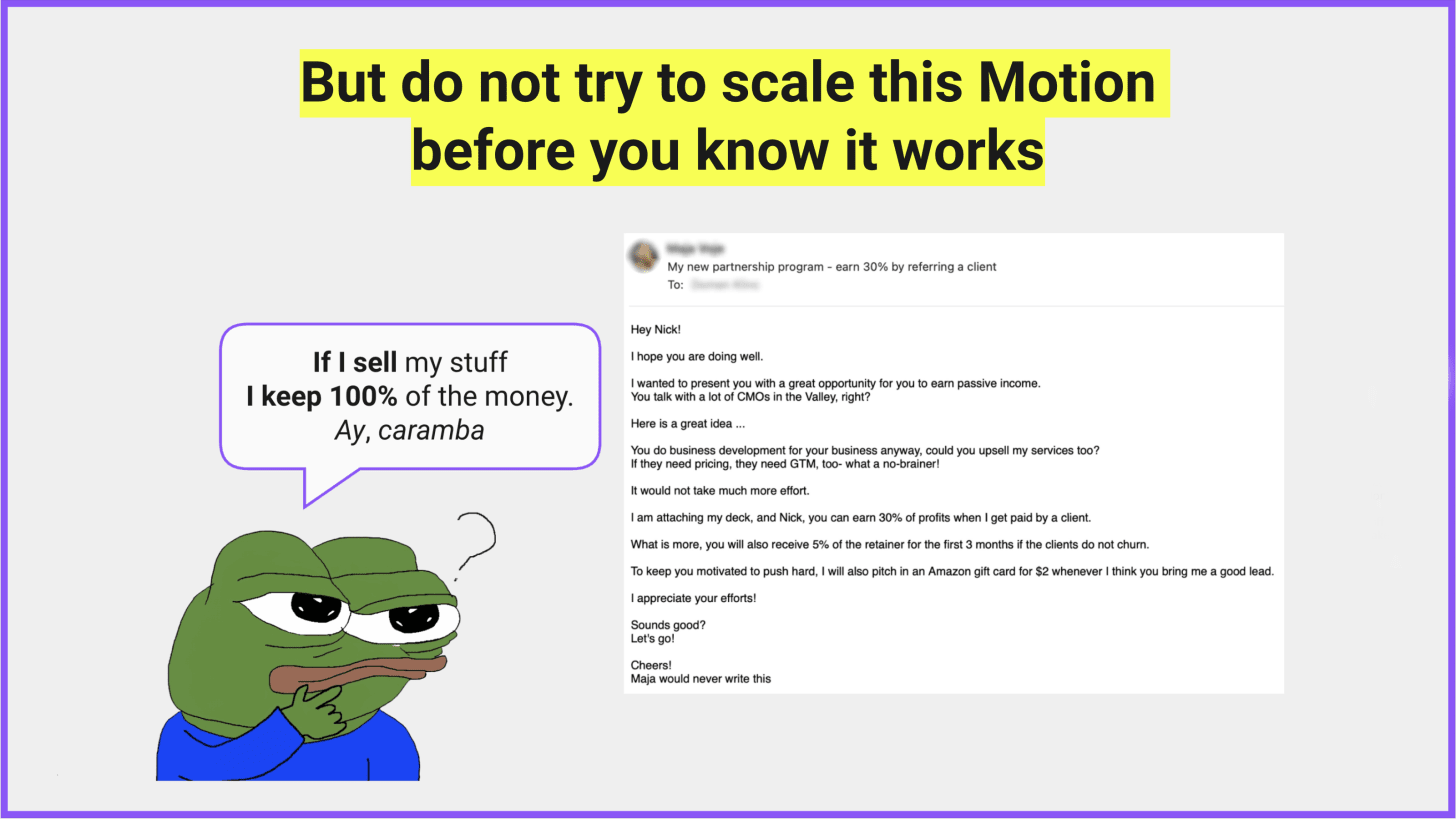
The issue is…
99% of such “Partners” will fail to produce ANY traction and probably the nicest reply you will get is “OK, I will keep that in mind”. And you and I both know that you will forget to follow up on these replies.
You need a strategic approach and a system for managing partnerships to turn Partnerships into a well-coordinated, repeatable and scalable GTM Motion.
Let’s learn from Nelson 🙌
Here is his Mega-deck called the “Partner Starter Kit” with FREE frameworks (88 FREE slides) that you can start using immediately:
✍️ And of course, I made some notes and invited Nelson to share more examples with you ❤️
Nelson’s strong point of view is: “Successful long-term partnerships are based on first-principles thinking. You can have some success with tactics and ad-hoc action and if you’re really lucky, you may even get to scale with that approach. But the key to unlocking Partnerships as sustainable and growing GTM Motions is to build partnership strategies based on fundamental principles that act as your north star. As an example: One of the most important ones is to be customer-centric.”
Nelson knows from experience that a clear and well-thought-out Partnership Strategy is the key to a robust Partnership Program. He kindly shared some of his best frameworks with you to help you get started.
Understand ICP and its Customer Journey Map (CJM) first
Everything starts with you mapping the end customer journey and knowing your ICP inside out. Only after you understand the CJM can you rightfully estimate at which points do partnerships make sense and deliver value for the end customer.

Suppose you are a complex CRM such as Hubspot or Salesforce. In that case, it makes sense to consider reselling partnerships with local agencies that help onboard customers and address their specific needs for customizations. If you sell software for upsells in hotels, partnering with local consultants to get your foot in the door of bigger hotel chains and help them adopt the program would make sense. Where do partnerships make sense in your CJM?
Nelson Wang shares an example from Hubspot (Source: Partnerinsight.io): Hubspot has a massive solutions partner program where partners offer CRM, IT/Integration, Web Dev, Marketing, and Sales Services to customers to help them on their journey. The results of this ecosystem approach? “Partnerships are the engine driving HubSpot's growth, contributing a staggering 45% of its revenue in 2022 and referring 33% of their customers. Not only are these partners driving almost half of the revenue, but they're also bringing in customers who pay more than the average.”
4Cs of Ideal Partner Profile
Building partnerships usually does not start with an outbound challenge to get as many partners as you can recruit. A massive number of partners with no focus or clear reasons as to why does not lead to success. It leads to noise.
Nelson Wang developed a useful framework, 4C of Partnerships, which helps you determine your Ideal Partner Profile by understanding:
-
Capacity - Company size, customer portfolio, team
-
Capability - Their expertise and proven part experience, and other key partnerships
-
Commitment - This has to be double-sided - same as you are interested in building the partnerships, they should also devote resources and time to making it worth.
-
Customers - Synergies are crucial - the partner must have access to the same economic buyer that you target. If not, you have a huge hill to climb that is often insourmountable.
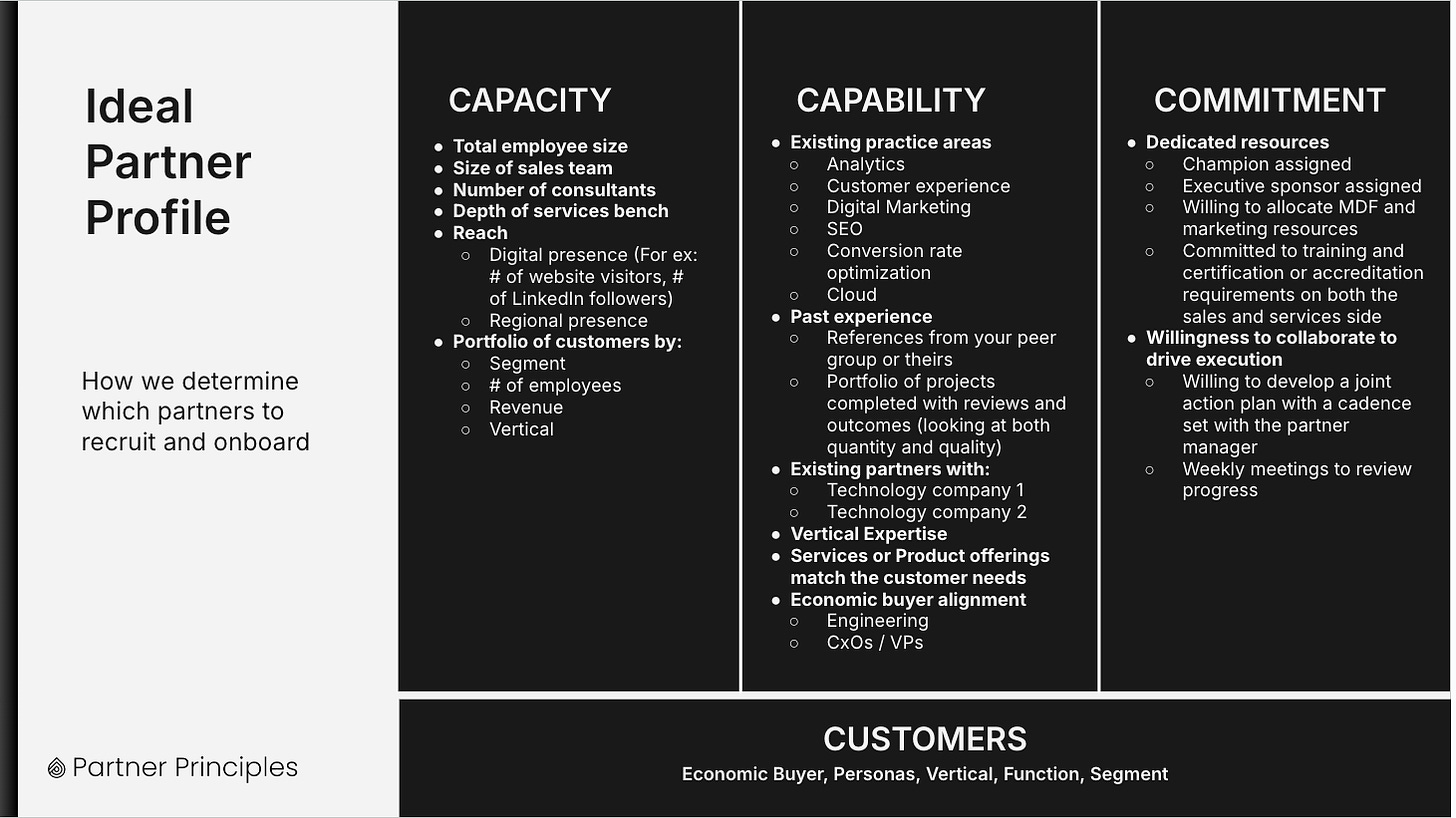
Prioritize your partnership activities (80-20% Rule)
The Pareto principle applies to partnerships, too.
20% of Partners will produce 80% of results in a scaled Partnership program.
Like many things in GTM, partnerships are not set-and-forget-it. To create a long-term partnership, you need to invest in educating, onboarding, and activating your partner, and you often need to give them business first.

Here are the best practices that you can use:
-
Align goals from the start. When you are negotiating the partnership agreement, it should be crystal clear to both parties what success looks like:
-
What are their goals?
-
What are your goals?
-
What are shared goals?
-
-
When will you value the partnership? What are the timeline and milestones?
-
How often should we check in with each other?
-
What communication line suits the partner - Slack community, partner resource center, email communication, or in-person meetings?
-
Accountability system - biweekly check-in, quarterly review, and ownership of the partnerships are well defined on both sides of the deal.
To set up the right metrics and KPIs, we need to understand the types of partnerships first.
5 Types of Partnerships according to Nelson Wang
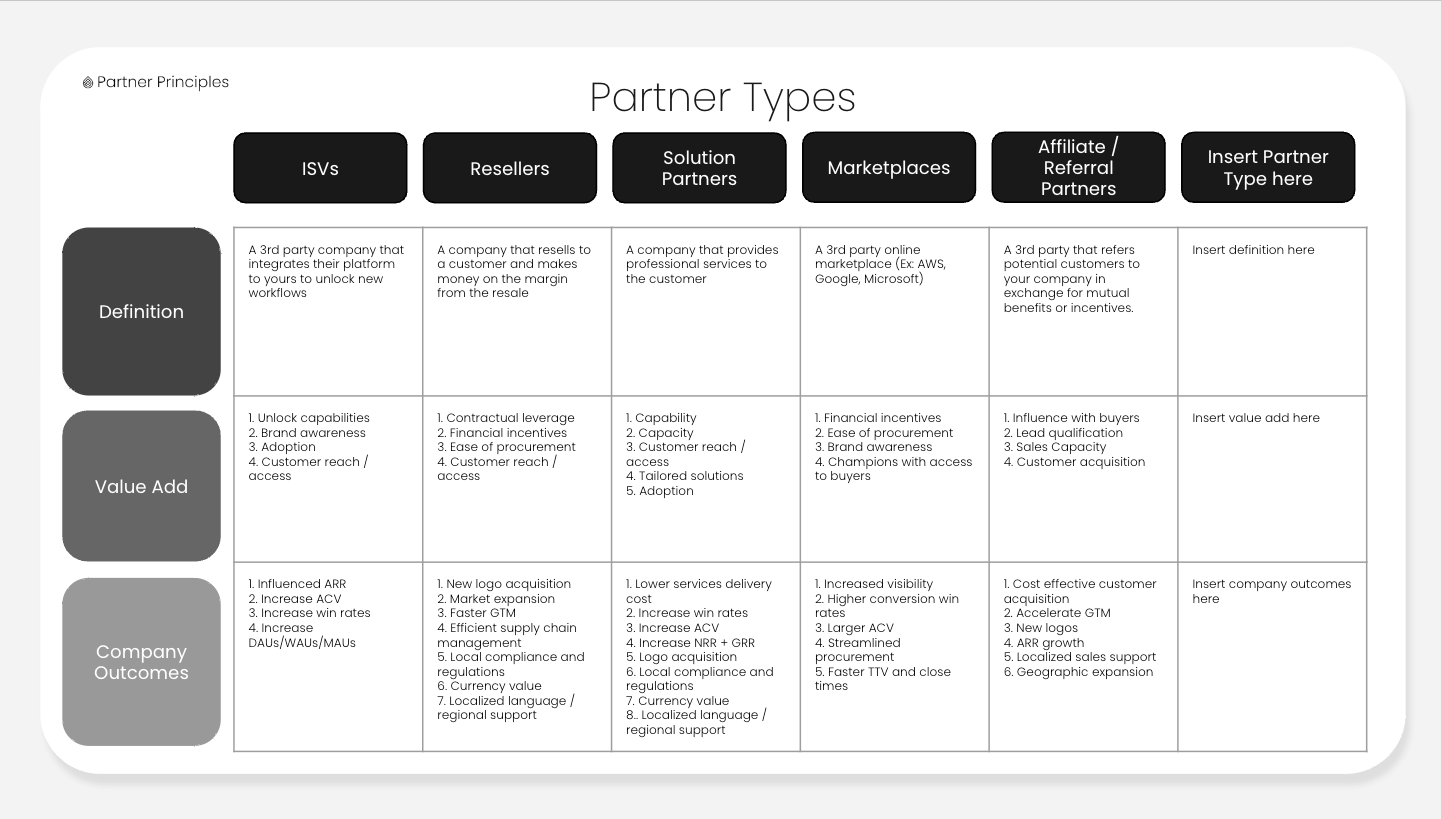
Now that you understand which stages of the customer journey partnerships could add the most value, you can start deciding which partner types to focus on.
For technology companies, Nelson defines 5 types of partnerships but qualified that different companies will different types of partners. This slide above is only meant as a starting point to help you ideate.
Here were the 5 on his initial list:
-
Independent Service Vendors - ISVs
-
Resellers
-
Solution Partners
-
Marketplaces
-
Affiliate/referral partners
He leaves room for you to customize this framework. In our podcast, we also discussed GTM Partners. You do not have to fix the boxes here. You have to develop partnerships that complement your customer journey and bring the biggest value to the end customer, your partner, and yourself.
Want more?
If you want to dive deeper and DIY your Partnership Strategy, I recommend the Partner Strategy Deck template (with a one-hour training video).

Nelson structured his learnings and best practices of building partnerships from zero to one at Box, Miro, Airtable, and Optimizely, leading to $150M+ in partner revenue. This deck took him 80 hours to put together and will save you countless hours and iterations.
I bought it with my own money, and I can assure you it is very useful.
But hey, don’t only take my word for it. The CEO of Workramp, CSO of WriterAI, Founder of Euler, Senior Partner Development Manager at AWS, the Founder of Hockey Stick Advisory, and many others think so. In fact, over 5,687 others have used his partnership templates to date! You can also see the list of testimonials here in the middle of the page.
Establish a 360° partner collaboration system to do it at scale
Now that you know who your successful partners are and how to activate them to unlock successful partnerships it is time to scale the partnership program. Now we are talking about Partnerships as a serious GTM Motion, not random campaigns.
You want to create a system of finding, activating, managing, tracking, compensating, and optimizing collaboration campaigns in a single place. These are jobs to be done:
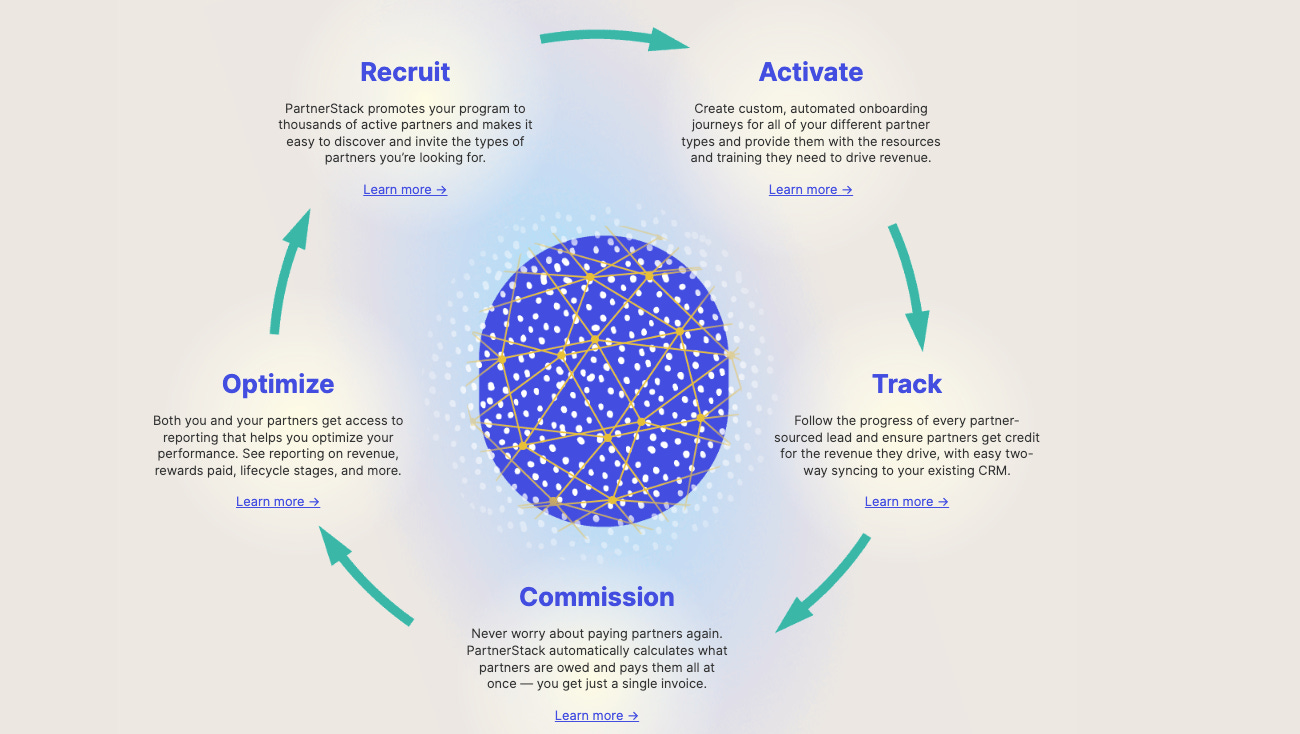
Here are the inspirational results that you can expect by investing in a full-fetched system of managing your partners, resellers and affiliates:
-
Apollo.io earns 10% of its revenue through its partner program
-
PandaDoc grew monthly recurring revenue by 47% YoY
-
Vendasta drove over $1.8M in affiliate program profits in less than 2 years
These examples are taken from PartnerStack, an all-in-one platform specialized for B2B SaaS. More than 500+ brands, such as Apollo.io Typeform, Zoom Info, PandaDoc, Thinkific, Freshworks, Vidyard, and many others, trust PartnerStack with their partnership management. G2 awarded PartnerStack the top-rated Partner Ecosystem Platform.
Here is how it looks in practice.
Even if you are not there yet, please watch the video because it will inspire you to take your system to the next level beyond timely and ineffective email correspondences.
If you have the audience or clients yourself that use SaaS solutions listed in PartnerStack Marketplace, you can even consider applying for becoming a partner yourself. The service is free and if you recommend this softwares anyway, why would you not make some money for promoting it too?
So what will it be, dear GTM Strategist?
You invested 5-10min in reading this post.
Which action points are the right ones for you to take next?
You are welcome to share your thoughts and questions in the comments 💬 (I reply to them!) all and hit ❤️ on Substack if you enjoyed this one to signal me that I should create more content like this to support you on your GTM endeavors.
Proof:
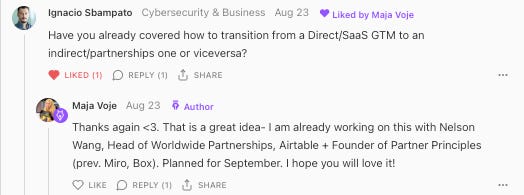
Let’s go to market!
Stronger together 🤝
- Maja
Join the newsletter to receive weekly tips on how to build and grow your partner program so that it drives revenue, net retention and cost efficiencies.


